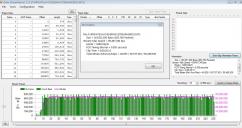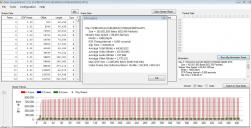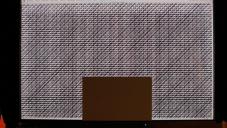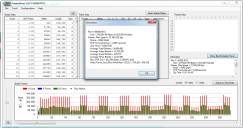
Please, support PV!
It allows to keep PV going, with more focus towards AI, but keeping be one of the few truly independent places.
It allows to keep PV going, with more focus towards AI, but keeping be one of the few truly independent places.
Official Low GOP topic
-
@Kae or anyone using his latest settings.
Could you post an entire stream parser frame mode bar chart for the 60 mb/sec GOP=3 while filming something completely static(No camera movement and no subject movement)? I would like to see the entire graph for a 10-20 second clip. If you could just zoom out until the whole clip is visible in the chart.
What I want to see is if the cadence of the codec is affected by the GOP. I just did some testing with the 32 mb/sec and 25 mb/sec settings and anything below a GOP of 12 will cause an irregular cadence. Now this irregular cadence is not necessarily bad. However, I would like to find out if the higher bit rate settings show the same thing. -
>Sorry I didn't see that one. Do you want to move my post over there or should I?
Please, do it yourself.
-
@nic2011
"That is a real dumb answer"
Really? Stick to your high GOP and 32mb/s then. No one is trying to sell or convince you of anything. It takes roughly 2 minutes to set settings in ptools, save the firmware and load it into the GH2. Load whatever settings you're curious about and SHOOT footage - LOOK at it, TEST it, do whatever you want to it and find out what works for you.
-
@mpgxsvcd
Just for you :-)
The screen grabs below are from a static 20 sec shot of the pappas codec chart with the 65Mb/s 3 GOP 1080 24p settings loaded (I don't have the 60 settings loaded, maybe someone else can test who does). Clip was shot off the LCD on my laptop, don't know if the screen refresh rate affects anything. lens was the 14-140 with auto-focus and ois off.

 20sec65MbExtreme3GOPdeathchartclipa.JPG1267 x 669 - 173K
20sec65MbExtreme3GOPdeathchartclipa.JPG1267 x 669 - 173K
 20sec65MbExtreme3GOPdeathchartclip.JPG1266 x 645 - 179K
20sec65MbExtreme3GOPdeathchartclip.JPG1266 x 645 - 179K -
-
@Kae
Thanks. That looks very consistant and those I frames are huge. Are those the settings with altered Video Bit rate "AND" Bitrate Top and Bottom settings? Could you post the settings file for that test? Thanks for the help. -
@mpgxsvcd / Prove that with a scientific 1 to 1 comparison and I will believe it. Otherwise I haven't seen any indication that extreme bit rates are producing a visual difference. /
Here's a "comparision" … don't know whether or not this is "scientific" enough … but that is what I am also seeing in actual footage (but only in dark tonal values).
I've shot my monitor displaying Kae's torture chart.
At the bottom edge of the monitor I've put up a grey card - lit with very low tungsten light (see jpg attachment). Camera set to daylight.
I've shot 24p at 24H (set to 52Mbits; real outcome in this scene is 43Mbits) and 24p at 24L (set to 32Mbits; real outcome = 32Mbits).
1080i50 and 1080p24 GOP Size=6.
Imported into Avid MC to DNxHD 10bit.
Added a curve (quite steep) to open up shadows (so a worst case scenario for tungsten). Rendered at 16bit.
Output "same as source" rec709 (hence to a DNxHD 10bit QT), cropped the grey card (the zipped video attached shows a 100% crop), transcoded to DVCPRO50 NTSC.
First 2 seconds represent 52 (actually 43) Mbits, second 2 seconds 32Mbits.
When you look at the left part of the video you will notice that the noise pattern changes after the first 2 seconds.
The difference is marginal and absolutely doesn't matter in most real life situatuions (IMHO) but it might matter under certain circumstances ...
You can download the 4'' video here: http://www.2shared.com/file/yvQYuU3K/noise_52vs32Mbit.html (6.9MB)

 screen.jpg600 x 338 - 121K
screen.jpg600 x 338 - 121K -
@jokami the footage is very very nice. On a technical side, the dynamic range seems to be very good. Until now this is the only part that I would like to know about the gh2 compared to the rest.
-
I don't know what happen with the above movie!!! Which I like a lot but got attached in my previous post.
-
Low GOP will do little, or nothing, for static resolution tests. You have to have a moving target to see any change to speak of. Think about it; let's say you have a GOP of 500 - as long as nothing changes, that would work just fine.
Static improvements require adjustments to quantization tables... coming soon...
Chris -
>Static improvements require adjustments to quantization tables... coming soon...
Wow, I wonder what can be further improved, I thought static, well lit shots are the situation were GH2 is at it's best already..can't wait
Thank you for your work Chris! -
@ mpgxsvcd
The static test chart was shot with the 65mb/s settings previously posted. Attached..
Edit: Load the second attachment setc.ini inside the zip - the first one is the wrong one (can't delete attachments here, don't know why.)
 KAEextreme65MB108024p_42MB720pand1080i.zip491B
KAEextreme65MB108024p_42MB720pand1080i.zip491B
 KAE65M1080_24P_3GOPand42M720_1080i_12GOP.zip511B
KAE65M1080_24P_3GOPand42M720_1080i_12GOP.zip511B -
@cbrandin
I agree that low ISO static shots will not benefit much for different GOP values. However, noise plays a huge part in determining the bit rate the camera uses. You can shoot a static scene at ISO 3200 or greater and easily max the bit rate out. All of the tests I have done so far where at ISO 3200. -
...and low GOP changes that?
-
When it comes to shadow noise, I think all the low GOP does is starve I frames (because there are more of them). The effect of that will be that the codec will use higher QP values on macroblocks. The higher the QP value, the less high frequency resolution you get, and noise is high frequency content. It does exactly the same thing as lowering the bitrate does in that context. I think you might want to try turning up the camera's noise reduction. Noise reduction occurs before encoding, so the codec can use bandwidth for other things instead of consuming itself with reproducing noise. It's the opposite of sharpening where extra, fake detail is produced causing the codec to expend bandwidth on something that isn't really there and can be better done in post anyway. I can certainly buy the idea that low GOP can improve temporal response, but not so much if the codec is maxed out because of noise.
Chris -
Strangely, the 35mbit 24L preset from Kae's 65mbit setting shows irregular gop bitrates. Any ideas?

 stramge.PNG1305 x 688 - 120K
stramge.PNG1305 x 688 - 120K -
I think the 24L isn't working right - I've seen this when all I did was change the bitrate to 22000000.
Chris -
@all Can we keep the basic questions/FAQ updated? Ive made a start which needs continually checking over. :-)
http://www.personal-view.com/talks/discussion/443/basic-questions/p1 -
@cbrandin I just tried turning up the cameras noise reduction to +1 in Nostalgia film mode at ISO 640 (-2 -2 0 +1) on a GOP3 60MB hack and the most obvious thing I noticed in Stream Parser is the B frames are considerably larger. However the stream was only averaging about 35MB for what I was shooting, I will try it with a more detailed shot in a bit.
Edit : Ah no, thats related to the lowlight and movement in the shot, just did a mostly static shot (averaging a 55mb rate) with and without NR and the streams look pretty identical in the parser (the max GOP size in the NR version is a smidge larger, but that could just be happenstance). Which is to be expected I guess. Is what your saying that turning NR on is worth doing, as we'll still get detail and the codec is spending its bandwidth catching detail and not noise ? -
@cbrandin
There is a difference between lowering the GOP and reducing the GOP to 3. When you lower it to 3 you completely remove P frames and replace them with I frames. However, something interesting seems to be happening here. It appears that the I frames stay the same size and the bit rate increases proportionally with the addition of the extra I frames.
I haven't been able to do a proper test of this yet. However, if that is the case then a GOP of 3 would in fact offer a more precise representation of all scenes than higher GOP values would. -
@Stray
That's exactly what I'm saying. If a bunch of noise is encoded, that detracts from bandwidth that could be devoted to other things. The encoded noise is of no value. You want to be sure not to overdo it, though, because NR can end up removing actual detail. Detail that is equal to the noise floor is virtually indistinguishable from noise - it's basic signal to noise ratio stuff.
@mpgxsvcd
That's true until you max out bitrate - then the codec will start compromising macroblock quality to avoid exceeding the allotted bitrate. It looks like in your tests the I frames are meeting target macroblock quality without maxing out allotted bitrate. The bitrate goes up with extra I frames because they are simply less efficiently encoded than P and B frames. Actually, it all makes sense to me. With a GOP of three, P frames are eliminated - that's fairly efficient. However, B frames are typically encoded with lower quality quantizations than P frames, so some detail may be lacking in B frames.
B frames are smaller than P frames for two reasons: They can use previous and future frames as references, which is more efficient that just using previous frames - I think everybody knows about this. B frames are typically encoded with a higher QP value (higher QP=lower quality) than B frames - maybe not so well known.
Chris
-
@mpgxsvcd
'Strangely, the 35mbit 24L preset from Kae's 65mbit setting shows irregular gop bitrates. Any ideas?'
That could very well be. I have never tested that mode as I have no use for it. Strange that it wouldn't work but maybe the doubling of the low/high/top bottom affects that mode negatively???? -
@mpgxsvcd
"I haven't been able to do a proper test of this yet. However, if that is the case then a GOP of 3 would in fact offer a more precise representation of all scenes than higher GOP values would."
So if this is in fact true, which visually it always seemed to me that it was, are you prepared to reverse yourself on 3 GOP and the very negative way you first reacted to the concept of it? ;-) -
@kae
Absolutely if I see streamparser results from a scientific test that shows that a GOP of 3 keeps the same bit rate for I frames and B frames as a GOP of 6 or 12 then I will eat crow. I haven't seen that scientific test done yet though.
I wasn't negative on a GOP of 3. I was negative about the statement that it produced a more film like look and the way everyone blindly accepted that it was better because the bit rate is higher. If there were scientific tests to show what it does either way I wouldn't have said anything. However, I simply don't believe it produces a more film like look. I have not seen any evidence to support that theory at all.
I hope that a GOP of 3 does turn out to produce the best results. It appears to be the most stable of the GOP values I have tested. The I frames always appear to have the same value and the B frames appear to be high as well. However, I haven't been able to determine if the total bit rate increases proportionally to the increase in bit rate from swapping P frames for extra I frames. If you want to demonstrate that to me then I am all ears. -
GOP 3 won't be more precise, just different. I frames are much less efficient than P and B frames, so the overall effective amount of information per frame is reduced with low GOP. Now, there are many good things that come with low GOP that are desirable, increased resolution of fine detail is not one of them though, in fact that's pretty much what you trade for the other good things.
Chris
PS I mean resolution in the frequency domain, which is somewhat different that resolution in the strictly visual domain.
This topic is closed.
← All Discussions Start New Topic


Howdy, Stranger!
It looks like you're new here. If you want to get involved, click one of these buttons!
Categories
- Topics List24,098
- Blog5,725
- General and News1,403
- Hacks and Patches1,153
- ↳ Top Settings33
- ↳ Beginners256
- ↳ Archives402
- ↳ Hacks News and Development56
- Cameras2,401
- ↳ Panasonic995
- ↳ Canon118
- ↳ Sony156
- ↳ Nikon96
- ↳ Pentax and Samsung70
- ↳ Olympus and Fujifilm102
- ↳ Compacts and Camcorders300
- ↳ Smartphones for video97
- ↳ Pro Video Cameras191
- ↳ BlackMagic and other raw cameras149
- Skill1,960
- ↳ Business and distribution66
- ↳ Preparation, scripts and legal38
- ↳ Art149
- ↳ Import, Convert, Exporting291
- ↳ Editors191
- ↳ Effects and stunts115
- ↳ Color grading197
- ↳ Sound and Music280
- ↳ Lighting96
- ↳ Software and storage tips266
- Gear5,420
- ↳ Filters, Adapters, Matte boxes344
- ↳ Lenses1,582
- ↳ Follow focus and gears93
- ↳ Sound499
- ↳ Lighting gear314
- ↳ Camera movement230
- ↳ Gimbals and copters302
- ↳ Rigs and related stuff273
- ↳ Power solutions83
- ↳ Monitors and viewfinders340
- ↳ Tripods and fluid heads139
- ↳ Storage286
- ↳ Computers and studio gear560
- ↳ VR and 3D248
- Showcase1,859
- Marketplace2,834
- Offtopic1,343








